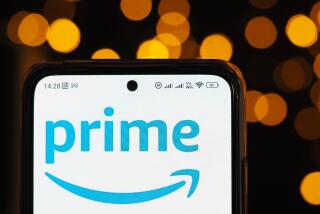Wide-open Verizon
- Share via
This is going to be painful to write, so I might as well get it over with quickly: Kudos to Verizon Wireless, which really does seem serious about opening its network to independent developers and phone manufacturers.
I can hardly believe I’m saying nice things about the “Can you hear me now?” company. Verizon Wireless is so driven to control what its subscribers do that it disables features on their phones and requires them to pay for things they ought to be able to do for free. In fact, it’s the last company I would have expected to see jump on the openness bandwagon.
After all, earlier this year it asked a federal court to block new Federal Communications Commission rules that would allow any application or device on just one small swath of mobile airwaves a portion of the 700 Mhz band, which the FCC is trying to convert from UHF TV signals into wireless broadband. I used this space in September to offer some, well, unkind words about the lawsuit, saying it “set a new standard for hubris.”
Verizon Wireless dropped that lawsuit in late October, foreshadowing the announcement late last month that it would essentially apply the FCC’s approach to its existing network by the end of 2008. Subscribers will be able to connect to the network with any phone or gadget that meets the company’s “minimum technical standard.” As for the software running on those phones, the barrier is even lower, according to the company’s news release: “Any application the customer chooses will be allowed on these devices.”
Contrast those words with this screed posted in May on Verizon’s PolicyBlog (Verizon and Vodafone jointly own Verizon Wireless), which pilloried a proposal by Skype to require mobile operators to allow any device and any application on their networks. Here’s an excerpt:
Skype’s 1960’s style intervention would impede carriers’ ability to prevent uses that might disrupt service to other subscribers, discourage continued capital investment in networks like the next generation of wireless broadband, and pose risks for first responders by creating hard to identify radio interference. Further, cellular companies are able to control and protect against security intrusions (such as spam), privacy intrusions (such as unwanted sales calls), and dangerous online hackers and predators because of the careful management they practice and the close quality control they can exercise over their networks.
The same arguments could be made against Verizon Wireless’ initiative, too. Evidently the risks are more palatable when shouldered voluntarily, rather than on Washington’s orders. Still, it’s worth noting that the company didn’t act entirely of its own free will. Its hand was forced to some degree by the FCC.
That’s because Verizon covets the 700 Mhz frequencies, including those covered by the FCC’s openness mandate. They’re the wireless equivalent of prime real estate, able to carry large amounts of data long distances. If it wins the auction for those airwaves, it would naturally want to integrate them into its current network, selling devices and service plans that worked on all the frequencies it was licensed to use. But that kind of integration would be troublesome at best if the different frequency bands operated under different rules.
It’s also conceivable that Verizon reached the same conclusion as Google, Nokia, Apple and numerous other tech-savvy players in the mobile arena: providing an open platform for third parties to use is actually good for business. By giving manufacturers and developers a (relatively) free hand to design products and applications, Verizon Wireless increases the odds that its network will have the most compelling offerings. Telecom analyst Dave Burstein recently gave one example: makers of portable music players, handheld game machines and other devices could incorporate Verizon Wireless’ mobile connectivity into their gadgets. Imagine an MP3 player that can stream music from your home PC or an online jukebox wherever it goes, or a pocket-sized game console that lets you join multiplayer online games while you ride the bus.
Some observers aren’t convinced by Verizon Wireless’ turnabout. In particular, they note that the degree of openness will depend on how the company implements its plans. Will Verizon Wireless offer discounts to people who supply their own phones? After all, its current rates are bumped up to cover the subsidies for the free or heavily discounted phones it offers. And when it tests phones from unaffiliated companies, will it impose restrictions not related to network safety, such as a ban on using Bluetooth connections to swap ringtones? Noting the company’s insistence on certifying equipment before allowing it on the network, Sascha Meinrath, research director of the Wireless Future Program at the New America Foundation, said, “By definition this means that they will not let certain devices on their network. This and other inconsistencies leave me deeply concerned.”
The company isn’t offering details about its plans yet, saying it’s too early. But the hints it has dropped are encouraging. For example, earlier this month its chief executive, Lowell McAdam, told Business Week that Verizon Wireless would offer phones built to the Android specifications from the Open Handset Alliance, a group that includes Google, Motorola, Sprint Nextel and a couple dozen other tech and wireless companies. Android phones are designed to be open platforms for software developers the antithesis of the typical U.S. mobile phone today. They’re not due to arrive until the second half of next year, so there’s plenty of time for Verizon Wireless to revert to its earlier form. Nevertheless, I remain hopeful that the company and its cohorts in the wireless industry have turned a corner, and that they’re ready to trade caution and control for the unpredictable but often magical benefits of technological innovation.
Jon Healey is a Times editorial writer; he runs the BitPlayer blog.
Send us your thoughts at [email protected].
More to Read
A cure for the common opinion
Get thought-provoking perspectives with our weekly newsletter.
You may occasionally receive promotional content from the Los Angeles Times.











